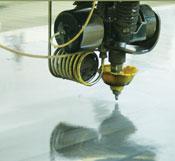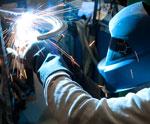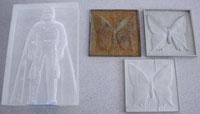Senior Editor
- FMA
- The Fabricator
- FABTECH
- Canadian Metalworking
Categories
- Additive Manufacturing
- Aluminum Welding
- Arc Welding
- Assembly and Joining
- Automation and Robotics
- Bending and Forming
- Consumables
- Cutting and Weld Prep
- Electric Vehicles
- En Español
- Finishing
- Hydroforming
- Laser Cutting
- Laser Welding
- Machining
- Manufacturing Software
- Materials Handling
- Metals/Materials
- Oxyfuel Cutting
- Plasma Cutting
- Power Tools
- Punching and Other Holemaking
- Roll Forming
- Safety
- Sawing
- Shearing
- Shop Management
- Testing and Measuring
- Tube and Pipe Fabrication
- Tube and Pipe Production
- Waterjet Cutting
Industry Directory
Webcasts
Podcasts
FAB 40
Advertise
Subscribe
Account Login
Search
Set design meets advanced manufacturing
Showman Fabricators uses advanced technology as a competitive edge
- By Tim Heston
- August 3, 2012
- Article
- Shop Management

Figure 1: Showman Fabricators built this kiosk on the floor of the New York Stock Exchange for CNBC.
New York City’s iconic 30 Rockefeller Center looks like it was made for television. It wasn’t, of course. It was built for radio, and the people at Showman Fabricators, most of whom have squeezed set pieces into the building’s tiny elevators and around tight corners, know this all too well.
Set fabricators for theater and television have always balanced a designer’s artistic vision with material and labor costs, as well as ease of transportation and efficient on-site installation (see Figure 1). Dec-ades ago most set designs were somewhat basic. If designers wanted an aluminum accent, fabricators didn’t use aluminum; they just coated less expensive material with a metallic-colored paint.
Now the balancing act has become more difficult because of the demands of modern performance media. High-definition TVs show every wrinkle on an actor’s face and every crack on a worn set. No longer can set builders make a metal-looking accent piece by painting over wood. Now they need the actual metal.
More metal has meant more machine tools to fabricate it. Showman’s metal shop in Long Island City, N.Y., has some traditional fabrication equipment like an ironworker and rollers for forming structural shapes. But it also has a CNC router for nonferrous metals, a CNC abrasive waterjet system, as well as several flat-part deburring and graining machines. Technicians work in 3-D CAD. Files are postprocessed from the front office directly to the router and OMAX® abrasive waterjet machine with a tilting jet that compensates for edge taper. And the company offers complete welding services (see Figure 2).
All this capability has helped Showman sell its services to some of the top show designers in the business. As Account Executive Jim Cummings explained, when producers and designers take a shop tour, their creative juices start flowing.
Company founder Bob Usdin, a 1984 graduate of the technical theater program at the State University of New York (SUNY) Purchase, grew up with theatrical scenery, both its traditions (hand layout and long-standing fabrication techniques) and challenges.
Such challenges included transportation. Usdin and his business partner knew this when they started Showman 25 years ago. They launched the firm by building one of the least glamorous but most critical elements of set fabrication for traveling shows: road boxes. Their original product reveals the fabricator’s pragmatic roots. If the set can’t be packed and shipped to the gig, it’s pretty much useless.
The company’s metalwork is a mix of mechanized efficiency and artistic experimentation. If a set needs a metal panel, say, with a circular grain finish, the shop sends the panel through its flat- part graining machine to see what comes out. Shop workers sometimes use mechanized machines instead of hand tools, but they still don’t have a specifically called out program for a certain grain finish. Experimentation and serendipity still play big roles.
But experimentation cannot hinder productivity. Schedules are just too tight. Showman technicians export set designs as exploded isometric views that look a bit like IKEA furniture assembly instructions, each customized for specific fabrication teams, to coordinate operations and reduce overall manufacturing time. These work instructions would make any lean manufacturing consultant proud.
Most Broadway shows these days have underlying frames made entirely of metal, usually steel tubing from 0.75 to 3 inches diameter. On occasion Showman is called upon to construct set pieces like balconies or walkways, using similar structural beams that support the theater building itself. The heavy-duty cutting usually is contracted out to local structural fabricators, but the Showman team does strategize how to move such immense set pieces into place.
All this has made Showman look more like a high-end contract fabricator and less like a traditional scenery shop. The spirit of the theatrical tradition remains, but it now must live with current realities of show business: Producers and designers want complex sets, be they realistic or fantastical, but produced faster and (of course) for the right price.
Waterjet Meets the Theater
Before purchasing the abrasive waterjet machine eight years ago (see Figure 3), designers were limited by what the shop’s router could produce. “Once the waterjet came onboard, we moved almost all of our aluminum cutting to the waterjet and quickly threw steel into the mix,” said Mike Riccio, design, engineering, and CNC department head. “It had the ability to perform very precise profile cutting, and it changed the way the staff and I thought about the way we build things.”
For instance, the set designer of NBC’s “Football Night in America” wanted to mount 103-in. plasma TVs on the set—some of the first plasma TVs of that size on the market. Yes, the TVs were thin, but 103 in. is 103 in., and at the time Showman couldn’t find an off-the-shelf bracket mounting system that suited the set design. So they waterjet-cut articulating brackets. Before the waterjet, such brackets would have been made with manual cutting, drilling presses, and complicated welding.
The waterjet isn’t limited to metal, of course, and this helped Showman bid for another high-profile job: the redesign of the White House press briefing room. The waterjet cut carpet tile with inlaid stars (see Figure 4).
High-Def Effects
According to Cummings, Showman produced one of the first news sets designed with high-definition televisions in mind. “This was the original MSNBC set,” Cummings said. “And this was a working environment. That’s where you can see people working, and the anchor desk was put in the middle of that environment. This means set design has moved on to real metals, real glass, and a lot of other high-end architectural products.”
Sets are continually being assembled and disassembled, and with that comes component wear. Metal components usually last longer than plastic or wood. In the past a wooden set piece painted to look like metal often got scratched or otherwise damaged. For analog TV, the set piece could be repainted, and no one probably would know the difference. Now that high-definition broadcasts have become the norm, that’s just not the case anymore.
A New Set, Now
If there were no cable TV, Showman Fabricators wouldn’t be where it is today. As Cummings explained, “We really grew up and grew strong as the cable television developed.” Unlike theater and the broadcast television studios, cable television contracted with nonunion shops. “We were a nonunion company, and that was a market we really could pursue.”
The company eventually did become a union shop to move into the theatrical and broadcast TV markets, but most of its work still comes from the cable television industry. It now has a core staff of about 40, but as many as 100 people may be working during the busy times.
To launch a project, a show producer contracts with a set designer. After the initial design, Showman is contacted to bid on the project. If awarded the job, the company works with the show designer to develop the best set design at the best price.
A recent job illustrates the typical timeline. “We were just invited to bid on a new project at ABC for Katie Couric,” Cummings said. “The client had engaged the designer, and there were five companies invited to bid on the engineering and construction of the project. That was two weeks ago. They narrowed it down to two companies, and we went back and forth on the budget, doing the value-engineering process. And in the end they selected Showman. Two days ago we were awarded the project. We had a production meeting yesterday with the design team, the producer, and the director of the show.

Figure 3: Showman Fabricators has a waterjet with an articulating head that accounts for edge taper.
“It’s about a 6,400-square-foot project,” Cummings added. The shop must construct that entire set in a matter of weeks—not months. As this magazine prints in late July, Katie Couric’s show will have started production.
A Different Kind of DFM
Riccio has a Bachelor of Fine Arts in sculpture and painting from the Maryland Institute College of Art, but considering his on-the-job challenges, he might as well have a degree in manufacturing engineering. In a way, he performs a design-for-manufacturability (DFM) analysis for every job. He juggles cost constraints with the designer’s artistic intent and production deadlines. Take the word artistic out of that sentence, and Riccio could be working for any contract manufacturer.
“The artistic needs of the design often come crashing onto the shores of budgetary constraints, physics, and installation experience—how we get a piece or unit into a performance venue,” said Riccio. “We need to be able to get very large architectural pieces of scenery into tiny elevators and narrow hallways with lots of turns.”
It’s a balance. Showman fabricates scenery elements large enough for quick on-site assembly, yet just small enough to ensure workers can transport set pieces to the studio or stage efficiently. At the same time, they avoid assemblies with undesired seams, which come glaring through on high-def TVs.
Sets are forever being assembled and broken down, which is why Showman’s workers always assemble and break down sets on the shop floor, before taking them to the performance space. This is where plates with tab-and-slot and other self-fixturing elements fabricated on the waterjet play an important role.
To meet tight production deadlines, the company has brought many processes in-house. As Cummings put it, “When a show is going on air or opening on Broadway in five weeks, it’s opening come hell or high water. So we’ve purchased bending and rolling equipment so we can roll our own steel and aluminum. We have a laminate press. We have a graphics department, so we can do in-house printing. We’ve moved to Inventor® [3-D CAD]. That has allowed us essentially to engineer every element of a set on the front end of every project.”
The subassembly concept, long a staple of production manufacturing, now pervades the company’s assembly floor. Design drawings in 3-D are broken down into smaller, exploded, IKEA-like instructions for specific subassemblies, what the company calls “kits,” which are sent to individual departments on the shop floor at specific times. The kits are fabricated at just the right time so that all components are ready for in-house assembly tests by a certain date. All this replaces some of the hand layout processes that have pervaded the set-building business for years.
The art of entertainment design has met the science of continuous improvement.
“This has made us much more competitive,” Cummings said, “because work on the floor flows much quicker. And it also means that rather than focus on front-end layout work, our guys are able to focus on quick assembly and the finish work.”
An Evolving Theatrical Tradition
Sources pointed out that some set design in the industry—especially for the theater—still abides by old stagecraft practices, as well they should. “These theater sets can be fantastical,” said Riccio. “That’s part of what the theatergoing experience is all about.”

Figure 4: Showman’s waterjet cut these carpet sections for the White House’s new press briefing room.
Big-budget Broadway productions aside, theater set design traditionally has operated on a shoestring budget, which means sets have been built mainly out of wood. For many theaters across the country, set-building practices haven’t changed much since vaudeville. Theatergoers know what they’re watching isn’t real. A wooden element painted with a metallic-looking coating may even enhance the experience more than an actual metal box. Realism isn’t the goal.
For movies and television, of course, realism can be the goal. A wooden box painted with a metal finish may look absurd or out of place. Many jobs call for real metal, and Showman Fabricators obliges.
It all comes back to the designer’s intent, and looks are everything. In the set-design world, form doesn’t follow function. Form is function.
Artistic Embossment on a Waterjet
Abrasive waterjets aren’t vertical CNC mills or ram-type electrical discharge machines (EDMs). They can’t cut away precise pockets of material. But as shop managers at Long Island City, N.Y.-based Showman Fabricators have found, their waterjet can indeed etch or emboss certain elements onto glass, acrylics, and metals. For the artists at Showman, the technology has broadened their creative palettes.
Kimball Smith, senior regional sales manager for Kent, Wash.-based OMAX, explained that the patent-pending process, called Intelli-ETCH, is a function of cutting speed. The slower the travel speed, the deeper the embossment.
The cutting head moves across the workpiece back and forth in the Y direction, moving a bit like a dot-matrix printer, embossing an image one line at a time. “The technology is software-driven,” Smith said, adding that the software creates “height maps” based on drawings input into the computer. “It isn’t a precision instrument, but we ’ve etched items like butterflies, and the minute features can be incredibly intricate.”
About the Author

Tim Heston
2135 Point Blvd
Elgin, IL 60123
815-381-1314
Tim Heston, The Fabricator's senior editor, has covered the metal fabrication industry since 1998, starting his career at the American Welding Society's Welding Journal. Since then he has covered the full range of metal fabrication processes, from stamping, bending, and cutting to grinding and polishing. He joined The Fabricator's staff in October 2007.
Related Companies
subscribe now

The Fabricator is North America's leading magazine for the metal forming and fabricating industry. The magazine delivers the news, technical articles, and case histories that enable fabricators to do their jobs more efficiently. The Fabricator has served the industry since 1970.
start your free subscription- Stay connected from anywhere

Easily access valuable industry resources now with full access to the digital edition of The Fabricator.

Easily access valuable industry resources now with full access to the digital edition of The Welder.

Easily access valuable industry resources now with full access to the digital edition of The Tube and Pipe Journal.
- Podcasting
- Podcast:
- The Fabricator Podcast
- Published:
- 04/16/2024
- Running Time:
- 63:29
In this episode of The Fabricator Podcast, Caleb Chamberlain, co-founder and CEO of OSH Cut, discusses his company’s...
- Industry Events
16th Annual Safety Conference
- April 30 - May 1, 2024
- Elgin,
Pipe and Tube Conference
- May 21 - 22, 2024
- Omaha, NE
World-Class Roll Forming Workshop
- June 5 - 6, 2024
- Louisville, KY
Advanced Laser Application Workshop
- June 25 - 27, 2024
- Novi, MI

































